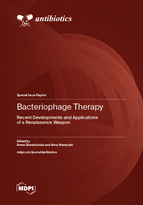Bacteriophage Therapy: Recent Developments and Applications of a Renaissance Weapon
A special issue of Antibiotics (ISSN 2079-6382). This special issue belongs to the section "Bacteriophages".
Deadline for manuscript submissions: closed (31 December 2023) | Viewed by 22584
Special Issue Editors
Interests: application of bacteriophages in human and veterinary medicine, development of the methods of working with phages; interactions of bacteriophages with bacterial and non-bacterial cells
Special Issues, Collections and Topics in MDPI journals
Interests: avian diseases; veterinary microbiology; bacteriophages in human and veterinary medicine; diagnostic tools for bacterial infections; antibiotic resistance; food-borne pathogens
Special Issue Information
Dear Colleagues,
During the last century, antibiotic therapy became the most powerful weapon against bacterial infections. However, the time for the universal application of these drugs seems to be running out. The number of new antibiotics being introduced to the market has been consistently decreasing and pharmaceutical companies have been reluctant to search for new products due to the high risk of failure. The diminishing potential of pharmacological treatment of bacterial infections is accompanied by an increasing number of antibiotic-resistant or, more broadly, drug-resistant strains. The inevitable need to search for and introduce new methods to combat bacterial infections is becoming unquestionable.
Bacteriophages have been used to treat bacterial infections nearly since the moment of their discovery at the beginning of the 20th century. However, overshadowed by antibiotics, phage therapy has been marginalized for decades. Nowadays, with the rapidly growing number of drug-resistant bacterial strains, phage therapy becomes one of the most promising alternatives to classical methods of treatment. Moreover, studies on bacterial viruses are not limited to human or veterinary medicine but increasingly reach new fields of biotechnology.
Dr. Aneta Skaradzińska
Dr. Anna Nowaczek
Guest Editors
Manuscript Submission Information
Manuscripts should be submitted online at www.mdpi.com by registering and logging in to this website. Once you are registered, click here to go to the submission form. Manuscripts can be submitted until the deadline. All submissions that pass pre-check are peer-reviewed. Accepted papers will be published continuously in the journal (as soon as accepted) and will be listed together on the special issue website. Research articles, review articles as well as short communications are invited. For planned papers, a title and short abstract (about 100 words) can be sent to the Editorial Office for announcement on this website.
Submitted manuscripts should not have been published previously, nor be under consideration for publication elsewhere (except conference proceedings papers). All manuscripts are thoroughly refereed through a single-blind peer-review process. A guide for authors and other relevant information for submission of manuscripts is available on the Instructions for Authors page. Antibiotics is an international peer-reviewed open access monthly journal published by MDPI.
Please visit the Instructions for Authors page before submitting a manuscript. The Article Processing Charge (APC) for publication in this open access journal is 2900 CHF (Swiss Francs). Submitted papers should be well formatted and use good English. Authors may use MDPI's English editing service prior to publication or during author revisions.
Keywords
- bacteriophages
- phage therapy
- application of phages
- antibiotic-resistance
- antibacterial therapies








